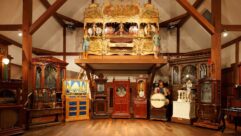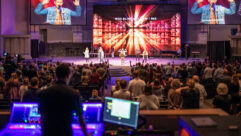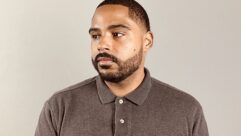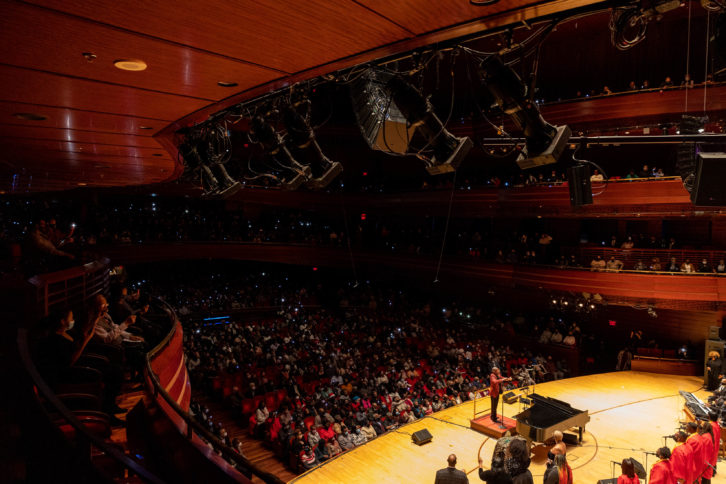
Audiences are returning to theaters hoping to recapture something of past joys, but also in search of something new. Either way it’s about connection—to audiences, performers, music, and an experience. The audio system is the conduit and facilitator for those connections and experiences. Let’s take a look at two examples where the Meyer Sound LEOPARD was deployed in two very different applications.
Verizon Hall at the Kimmel Cultural Campus is the home of the Philadelphia Orchestra, and a popular touring stop for all kinds of performers. One of the largest venues on the campus, Verizon Hall opened 20 years ago with a center cluster of Meyer MSL-4 loudspeakers. By Fall 2021, it was time for an audio upgrade and a reconfigured left/right design to make room for video elements at the center.
The orchestra itself plays unamplified, relying on the venue’s world-class acoustics. However, the Philly Pops and visiting artists needed a system worthy of the hall, able to complement its acoustics, and able to flexibly serve a wide range of musical styles and spoken word, including movie events that would utilize the new center screen in the 2500-seat 360-degree hall.
Because of their long collaboration with the team at Verizon Hall, Meyer was instrumental in the upgrade, and turned to local partners Dave Brotman and Michael Shoulson of DBS Audio for due diligence and installation and to take the project from line array shootout to opening day. DBS has a production side and an install side and Brotman feels the 30-something years of production underpins the company and influences their work on the installation side. “We’re always thinking about how it hits the end user, as an experience, and also as a flexible tool. The audio system is really an extension of the show, part of the show.”
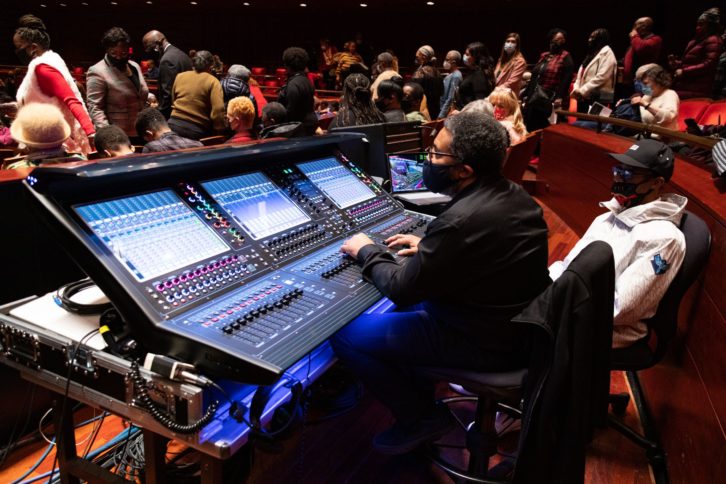 Brotman says they were fortunate to have the front-of-house engineer Kenny Nash and the AI Walter Bass on the install team. By the time all the wire was pulled and the hang was done, the in-house people were very familiar with the system. “We were able to come up with a variety of snap shots for the Galaxy processors that would work for them and encompass most of their needs.” With DBS only an hour away from Kimmel and with various remote diagnostics in place, that mind meld will carry on through the life cycle of the system service. Brotman also mentions value of collaboration with Director of Production Andre Barette and Eileen Harris, production manager.
Brotman says they were fortunate to have the front-of-house engineer Kenny Nash and the AI Walter Bass on the install team. By the time all the wire was pulled and the hang was done, the in-house people were very familiar with the system. “We were able to come up with a variety of snap shots for the Galaxy processors that would work for them and encompass most of their needs.” With DBS only an hour away from Kimmel and with various remote diagnostics in place, that mind meld will carry on through the life cycle of the system service. Brotman also mentions value of collaboration with Director of Production Andre Barette and Eileen Harris, production manager.
As a measure of how important this system was to the Kimmel, another leading collaborator was Matías Tarnopolsky, President and CEO of The Philadelphia Orchestra and Kimmel Center, Inc. Tarnopolsky’s title reflects the formation of a new parent company formed between The Philadelphia Orchestra and the Kimmel Center. In addition to the Kimmel Center for the Performing Arts (Verizon Hall, Perelman Theater, SEI Innovation Studio, and the Merck Arts Education Center), the campus also includes — at separate locations — the Academy of Music and the Merriam Theater.
Most of the hall seating is covered by the twin arrays of 12 LEOPARD line array loudspeakers, with nine LEOPARDM80 versions for the longer throw over three standard versions for nearer seats. The wrap-around seating is accommodated by mirror image flown subsystems on each side, each with single ULTRAX40 and ULTRAX23 loudspeakers on the upper bar with two ULTRA-X40 loudspeakers and a single ULTRAX20 on the lower bar. Extending the high frequency coverage to the top few rows of the third tier was supported by two ULTRA-X40. Deep bass reproduction is supplied by six groundstacked 900LFC low-frequency control elements, three per side in cardioid configuration.
Through the deft use of some KSG Inclinometers–two KSG RECLINE Standard Sensor Unit (SSU) and one RECLINE Dual Input Display (DID)—DBS was able to set the Verizon Hall team up with a way to easily set angles and do turnover between acts.
 Acoustically the environment was engineered to accommodate varying decay needs. There are hydraulic doors on all three levels to change reverb times, and drapes that wrap around acoustics chambers.
Acoustically the environment was engineered to accommodate varying decay needs. There are hydraulic doors on all three levels to change reverb times, and drapes that wrap around acoustics chambers.
Brotman fondly remembers sitting with Meyer’s iconic Bob McCarthy to tune the room. “I was familiar with the LEOPARD from previous installs. The EQ is easy no matter what you do with it. It’s sonically very transparent—it does what you tell it to do. At 75 pounds I feel like I can use it in so many different applications.” For the Kimmel, which was down to the wire on the install, that kind of ease of use was important. The blend with the Ultra-X fills was another key factor.
Brotman says that aesthetic appearance was equally important in what is a stunning room. Custom fabrication did the trick. Mountain Production built several ingenious rigs, including custom beams for the side and upstage hangs that had to collapse and fly when not in use.
For Verizon Hall, system design was a repeat performance by Meyer Sound Director of System Optimization Bob McCarthy. DBS Audio Systems of nearby Coatesville was the integrator, under the direction of Dave Brotman, with custom rigging for the side hangs engineered and fabricated by Mountain Productions of Wilkes-Barre, Pennsylvania. Project and acoustical consultant was Chicago-based Threshold Acoustics.
Meanwhile, two hours away on Broadway, LEOPARD took on a very different installation in a classic theater, half the size of Verizon Hall and many years older. For this deployment LEOPARD was serving one of the most innovative and intimate re-imaginings of a Broadway experience—David Byrne’s American Utopia. The show earned acclaim as a Grammy-nominated record album, a sellout concert tour, an HBO film directed by Spike Lee, and finally as a Tony Award-winning Broadway production in a split run. The first engagement, at the intimate Hudson Theatre, ended its performances in February 2020 and a second run at the larger St. James Theatre opened in September 2021 and closed it’s scheduled run in April. For both productions, Meyer Sound LEOPARD line array loudspeakers anchored the main audio systems.
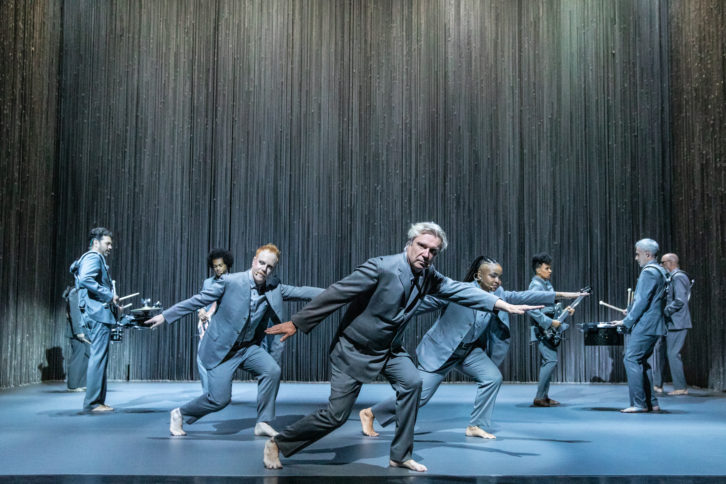 Visually and aurally, American Utopia is atypical of Broadway. There is no set, and for music there is no isolated “pit” band relying on click tracks and pre-records. Instead, all music is played live on the stage by an ensemble (including Byrne) of twelve musicians/ vocalists, with six on percussion and all twelve on vocal mics. Everybody is completely mobile using wireless connectivity, allowing for a freeform choreography that blends the fluid movements of Brazilian percussion ensembles with the disciplined formations of American marching bands.
Visually and aurally, American Utopia is atypical of Broadway. There is no set, and for music there is no isolated “pit” band relying on click tracks and pre-records. Instead, all music is played live on the stage by an ensemble (including Byrne) of twelve musicians/ vocalists, with six on percussion and all twelve on vocal mics. Everybody is completely mobile using wireless connectivity, allowing for a freeform choreography that blends the fluid movements of Brazilian percussion ensembles with the disciplined formations of American marching bands.
Managing the mix on this shifting mosaic of sounds is Pete Keppler, a veteran FOH engineer who came on board prior to the tour and mixed the shows at outdoor festivals and in venues clustered in the 3,000 to 5,000-seat range. When American Utopia transitioned to the 970-seat Hudson Theatre, Keppler sought a loudspeaker system scaled to a new set of demands.
“There was essentially no room beside the proscenium, and the creative team was adamant that the arrays stay out of sight lines,” says Keppler, who took on the dual role of sound designer and production sound mixer. “I needed a powerful system suited to rock levels but with a slender profile. I consulted with the crew at Sound Associates, and they recommended LEOPARD. I had heard LEOPARDs before as delays and in some smaller tour venues, and I liked them. I immediately agreed.”
The main hangs at the Hudson were relatively straightforward, with left and right arrays of twelve LEOPARD line array loudspeakers. “That was far more power than I needed, but I needed the array height to cover the vertical,” says Keppler.
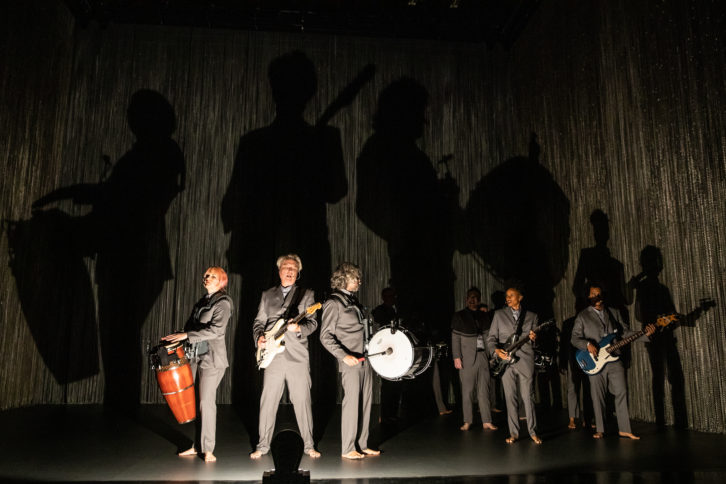 The follow-up production at the 1,710-seat St. James Theatre was more complicated as the location of box seats required a split array configuration, with six LEOPARD loudspeakers on the lower hang and eight on the upper. Six LEOPARD loudspeakers were set three per side as infills, with ten more as balcony delays. Eight 900-LFC low-frequency control elements fill out deep bass, while five UPJ-1P and eleven UPJunior loudspeakers were deployed in fill and delay systems. Four Galileo Callisto processors provide system drive and optimization.
The follow-up production at the 1,710-seat St. James Theatre was more complicated as the location of box seats required a split array configuration, with six LEOPARD loudspeakers on the lower hang and eight on the upper. Six LEOPARD loudspeakers were set three per side as infills, with ten more as balcony delays. Eight 900-LFC low-frequency control elements fill out deep bass, while five UPJ-1P and eleven UPJunior loudspeakers were deployed in fill and delay systems. Four Galileo Callisto processors provide system drive and optimization.
“LEOPARD is the best smaller PA I’ve ever had my hands on,” says Keppler. “What I’ve gotten out of it at both the Hudson and the St. James is absolutely wonderful, exactly what I wanted to hear. And I’m also a big fan of the 900 subs. They impress me as being very musical. I can hear the full spectrum of bass notes from keyboard, low guitar strings, and drums tuned to specific notes.”
Keppler was equally pleased with the integrated suite of design and optimization tools. “The [Meyer Sound MAPP] modeling software was great. When we set up the system, the coverage went exactly where it was supposed to be. The Galileo processors sound really good, and I love the Compass software. It’s easy, intuitive and boots up on a tablet in seconds. Domonic Sack from Sound Associates did the time alignment, showed me a couple things with it, and I just took it from there.
“I also have to give credit to Sound Associates, definitely one of the best sound companies I’ve worked with. Domonic, Peter Fitzgerald, Greg Reif, and Bob Hanlon, along with Matt and Joe Maloney, all greatly contributed to the success of this show.” Front-end equipment for the Broadway production includes 70 channels of Shure wireless with Axient digital for microphones and PSM-1000 systems for IEMs. Keppler mixes on a DiGiCo SD10 console equipped with a Waves outboard processing package.


